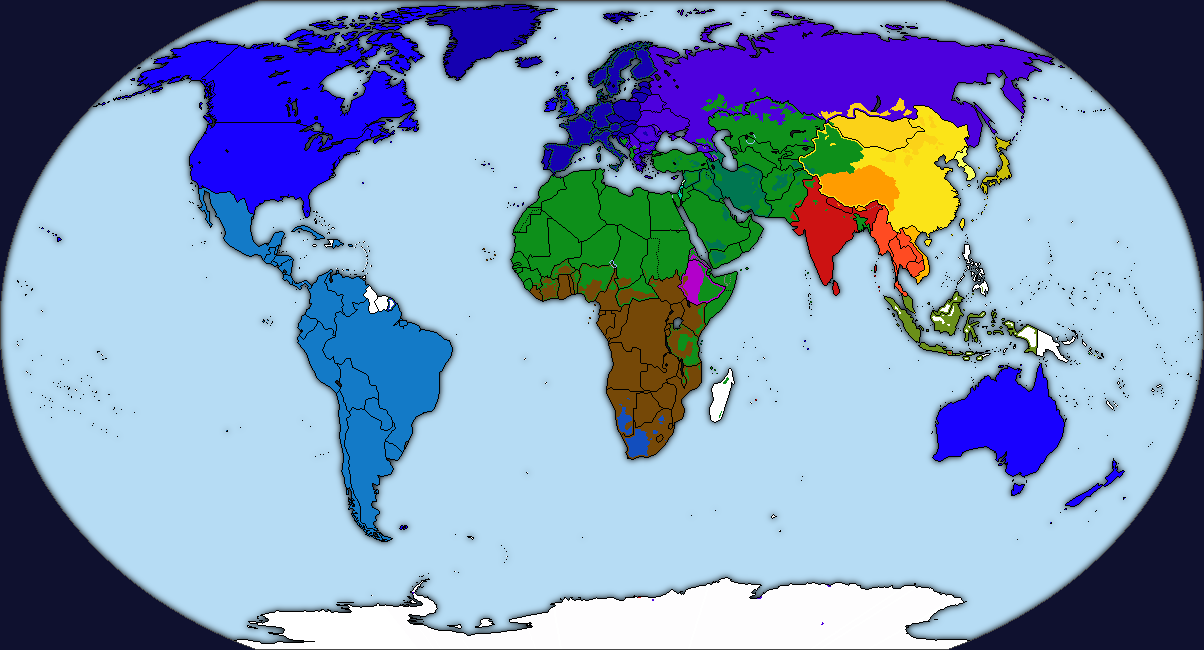maps-and-tables.neocities.org by Ludomir Filas
Last updated: 2021
This world map shows the civilizations of the world today. The classification is largely based on Huntington's "Clash of Civilizations" (e.g. a separation of Western, Orthodox and Latin American civilization and a separation of Chinese and Japanese civilization). I added a few more distinctions, such as the separation of the "Buddhist civilization" into a Tibeto-Mongolian and an Indochinese one or the separation of the "Islamic civilization" into a Sunnitic-Arabian one an a Shiitic-Persian one (which is relevant in today's conflicts in the Middle East).
The colour of the inner border of a country indicates the alignment of the government (e.g. the Chinese government trying to dominate the Muslim Uyghur and the Buddhist Tibetan cultures within its borders or parts of the West European governments promoting Islam).
Source: maps-and-tables.neocities.org by Ludomir Filas

| Culture | Main/traditional religion | Classical language | Today's lingua franca1 | Traditional calendar system2 | ||||||||
| Derived from Sumerian, Egyptian & Minoan cultures | Graeco-Roman origin | Western civilization today | Christian | Western (Orthodox) | Christianity (Eastern Orthodox) | Greek, Old Church Slavonic | Russian | Roman → Julian | ||||
| Classical Latin | Western (Continental) | Christianity (Catholic & Protestant) | Latin | German, French, Italian | Roman → Julian → Gregorian | |||||||
| Western (Anglosphere) | Christianity (Protestant) | Latin | English | Roman → Julian → Gregorian | ||||||||
| Western (Cape African) | Christianity (Protestant) | Latin | Afrikaans | Roman → Julian → Gregorian | ||||||||
| Western (Latin American) | Christianity (Catholic) | Latin, Quechua, Nahuatl | Spanish, Portuguese | Roman → Julian → Gregorian | ||||||||
| Semitic origin | Ethiopian | Christianity (Oriental Orthodox) | Ge'ez | Amharic, Tigrinya | Egyptian → Coptic → Ge'ez | |||||||
| Jewish | Judaism | Hebrew | Hebrew, Yiddish | Babylonian → Hebrew | ||||||||
| Muslim | Classical Arabic | Muslim (Sunnitic-Arabic) | Islam (Sunni) | Arabic | Arabic, Turkish, Urdu | Islamic | ||||||
| Muslim (Shiitic-Persian) | Islam (Shia) | Persian, Arabic | Persian, Arabic | Babylonian → Old Persian → Zoroastrian → Jalali → Solar Hijri | ||||||||
| Indian cultural substrate | Muslim (Malay) | Islam (Sunni) | Arabic | Malay/Indonesian | Islamic; or Hindu → Javanese | |||||||
| Indosphere | Classical Sanskrit | Indian (Hindu) | Hinduism, Jainism, Sikhism | Sanskrit | Hindi | Hindu | ||||||
| Buddhist | Indian (Indochinese) | Buddhism | Sanskrit | Thai, Khmer, Burmese, Lao | Hindu → Buddhist | |||||||
| Indian (Himalayan) | Buddhism, Bön | Sanskrit | Tibetan, Chinese | Hindu → Buddhist → Tibetan | ||||||||
| Sinosphere | Sinic (Mongolian) | Buddhism, Tengerism | Mongolian | Mongolian | Chinese → Uyghur → Mongol | |||||||
| Confucian thought | Classical Chinese | Sinic (Vietnamese) | Buddhism, Vietnamese folk religion | Chinese | Vietnamese | Chinese → Vietnamese | ||||||
| Sinic (Chinese) | Buddhism, Taoism, Chinese folk religion | Chinese | Chinese | Chinese | ||||||||
| Sinic (Korean) | Buddhism, Korean folk religion | Chinese | Korean | Chinese → Korean | ||||||||
| Sinic (Japanese) | Buddhism, Shintoism | Chinese | Japanese | Chinese | ||||||||
| Black African | Christianity, folk religions | n/a | English, French, Portuguese, Swahili | n/a | ||||||||
| Other: Malagasy, Black Caribbean, Philippine, Papuan, Pacific, Oriental Christian, ... | ||||||||||||
|
1 in intercultural settings, English is the lingua franca 2 now mostly replaced by the Gregorian calendar for daily use | ||||||||||||
Can someone who is good with HTML/CSS please help me figure out why the rows in this table have different heights? Especially in Chromium-based browsers (it looks much better in Firefox).